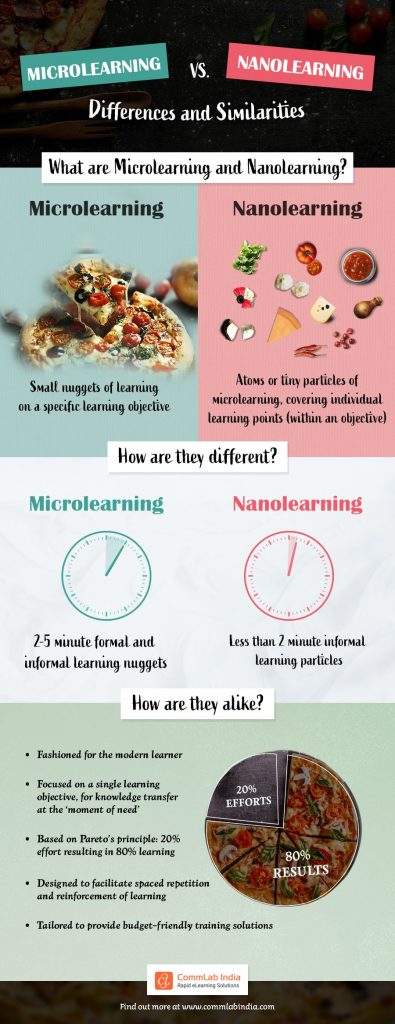We live in an age where learning how to do simple things is easier and quicker than ever. This is due to short videos that teach us how to do things like how to make interesting shoe-lace designs, how to buff a scratch out of car paint, how to put together a computer, how to unclog the shower drain, how to study more efficiently… the list is already seemingly endless but is growing exponentially every day. Microlearning is a term many of us have come across, which is a piece of learning that is digestible and useable within 7 minutes or so. Nanolearning takes this one step further and attempts to teach viewers things within 1-2 minutes, tops. I find the idea of microlearning being too long of a learning session so as to necessitate the creation of nanolearning really speaks volumes about where our mobile culture has come from and where its headed. There is a lot to be said about this, both positive and negative, but regardless of what is said, the fact that we now have the ability to produce helpful videos that are under 60 seconds long, that are accessible and sought after by countless people, is due in large part to mobile technology. As such, nanolearning has a lot to say in the conversation of mobile culture. Source: https://blog.commlabindia.com/elearning-design/microlearning-nanolearning-differences-infographic


I’m seeing a lot of the nano-learning through apps like TikTok, where students are telling me about these things that they have learned via TikTok and are asking me if its true, or to expand on it, increasing from nano-learning to micro-learning. Very interesting. The structure of the class that Nicole Kenny talked about sounds a lot like my classes, in that we start with a warm up, have some lecture (never more than 20 minutes), then we discuss what we learned and see if there are any extensions or connections we can make to other learning, and then we have a 10-20 minute window of time for reflection, where the students complete a reflection on what they learned, what surprised them, etc. It seems to work.
The idea of both microlearning and nano learning is fascinating. As Janice noted above, our attention spans continue to shrink. I wonder if our attention spans are shrinking or if we have always had this issue and the advancement of mobile technology is allowing us to see it more clearly or in a different light. Take students or employees with ADHD. They struggle to control their impulses and sit still and focused throughout the entire lesson or training session. Like speed dating or HIIT (high-intensity interval training) sessions, our bodies and minds can make quick decisions or improve themselves in very short bursts of time. Could this be a solution to support education whether it is mobile or face-to-face? I had a professor in university that broke his 50-minute class down into sections. The first 5 minutes he had a cartoon joke on the overhead (yes, overhead) and allowed the class to laugh and talk freely. This was followed by 20 minutes of teaching where he demanded attention and no talking. He then gave us another 5 minutes to chat after he told a joke or shared another cartoon and the last 20 minutes were focused teaching and learning. As a student, I will say this concept worked. I was focused, my notes were excellent, but most of all my recall was next to none and required very little studying to do well in the exams. Sectioning off an online program could be done similarly and would be interesting to learn if students found a difference in uptake and recall of the content learned or if companies saw an improvement in employee training and engagement.
This is such an interesting thread, and a personal fascination of mine. My natural reaction is to chastise ‘nanolearning’ and the surge of tiktok as a mode of delivery. Yet, to be fair, I think our initial dismissive reaction toward ‘just in time’ learning might be a little misplaced. The question I continue to ponder – and some of you may be able to shed light on this – whether there is a systematic way to approaching such learning to ensure it is meaningful. Of course, how we define ‘meaningful’ will differ based on a variety of factors, but it is a question that is still worth exploring.
Our attention spans continue to shrink! This is interesting and I think is relevant to Emma Pindera’s post about Just-in-time learning: https://blogs.ubc.ca/etec523/2021/01/26/just-in-time-learning-walk-me/
Perhaps we have become lazy learners or perhaps this style of learning in snippets as needed is simply optimizing the learning process and is a result of us accepting the reality of our capacity to learn.
Indeed, these discussions definitely go hand in hand. Also, as you exemplify, there is indeed a lot to say on both sides of the conversation! I wonder if we are standing on the cusp of a great change…
I was actually discussing this with someone a few days ago. We are aware that students tend to check out mentally with lessons that are long – more than a couple of minutes. TikTok is a application we can learn from. Quick lessons in a short amount of time would be fantastic since it would be easy to digest and remember. Some material would be difficult to explain in that short amount of time – but is it impossible?
Hey Andrea!
Ya I guess that’s the ultimate question: where is the line in terms of content vs time for Video Primary learning? I’m not sure we have found the answer quite yet…